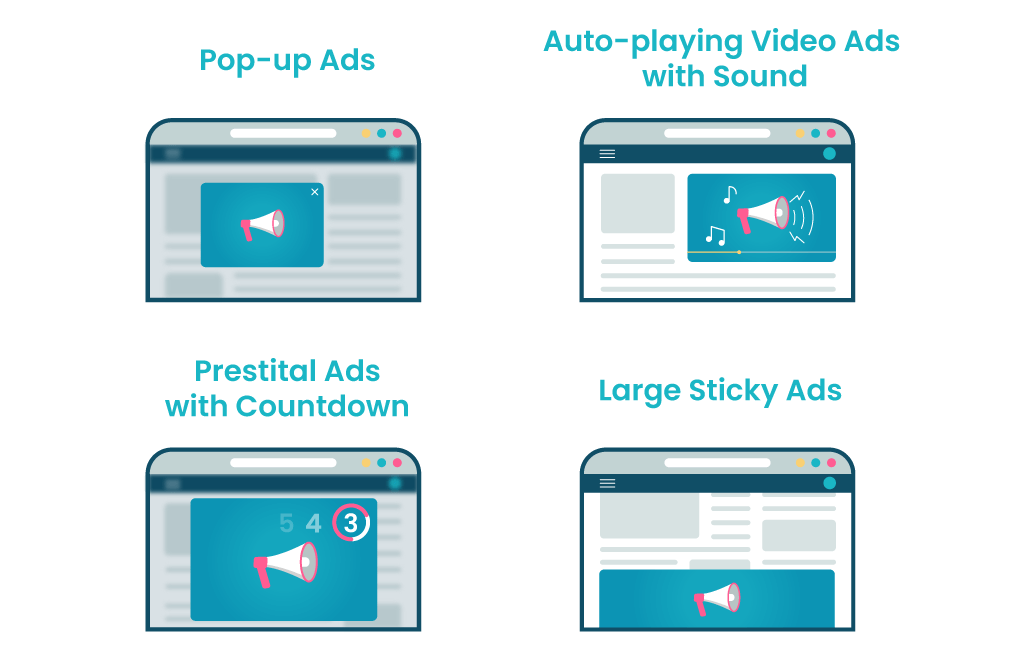Better Ads Standards: What Publishers Need to Know
For years the advertising industry needed a solution that would conceptualize acceptable ad formats. And we finally saw it in 2017–the Better Ads Standards.
The Better Ads Standards were developed by the Coalition for Better Ads–an international body of leading online media companies and trade associations responsible for overseeing and developing global online advertising standards.
In this article, you’ll learn everything you need to know about Better Ads Standards.
What are Better Ads Standards?
The Better Ads Standards are a global framework developed by the Coalition for Better Ads. It is based on extensive data from over 66,000 consumers across Europe, North America, Asia, Latin America, and Africa–regions accounting for 70% of the global online ad spend.
The Better Ads Standards currently identify 4 intrusive ad formats for desktop and 8 for mobile. Such ad formats are least preferred among consumers and are likely to cause more consumers to adopt ad blockers. Publishers, therefore, are encouraged to avoid them.
- 4 Intrusive Desktop Ads

- 8 Intrusive Mobile Ads

- 3 Intrusive Video Ads

In 2020, the Better Ads Standards included 3 short-form video ad formats that also fall beneath the acceptable ad format threshold.
How to Comply With Better Ads Standards?
Do a self-review for your website in Google Ad Experience Report, which you can access through Google Search Console.
The Ad Experience Report will run a test for your site’s desktop and mobile pages and highlight any violating ad experiences. You should work with your webmaster or AdOps specialist to fix any issues you may have and then re-submit your website for an additional check.
Publishers can also get certified for the Coalition’s Better Ads Experience Program, which will help advertisers identify which publishers’ websites meet the Better Ads Standards requirements. In addition, by signing up for the program, you agree not to serve disruptive ad formats outlined in the Better Ads Standards.
How Better Ads Standards Affect Publishers?
Firstly, Google Chrome, a web browser with a 65.27% usage rate, will block all ads that don’t comply with the Better Ads Standards requirements. It will first issue a warning to the publisher. If no action is taken, a publisher may no longer display ads. Besides, other browsers like Microsoft Edge said that they will do the same.
Secondly, one of the biggest challenges for publishers when serving ads is ad blockers. According to the Coalitions’ research, serving intrusive ad formats results in more demand for ad blockers.
On average, 41% of internet users in the US were deploying ad blockers in 2020. Ad blocker usage rates in Europe and North America have slowly declined since 2017 when the Better Ads Standards rolled out.

Source: AudienceProject
In addition, with Google’s updates such as Core Web Vitals, website performance is now inseparable from user-friendliness and user experience.
Benefits of Better Ads Standards
Here are 6 benefits for publishers that comply with the Better Ads Standards:
- Non-intrusive ad formats contribute to a better user experience, which is one of the key factors for SEO.
- Reduced number of ad blocker users.
- Publishers can benefit from higher user engagement by switching to better ad practices.
- Non-intrusive ad formats result in more ad revenue in the long-term.
- High-paying advertisers are cautious of their brand image, therefore, they are unwilling to show ads that are intrusive or disruptive for users.
- As the industry shifts towards a user-centric approach, publishers can expect to see more ad spend going to good ad experiences.
Remember, by substituting intrusive ad formats for more ads you might hurt your ranking and user experience even more. You should follow the best practices regarding both ad formats and ad count.
Related Article: How Many Ads Should I Put on My Website?
Conclusion
The goal of the Better Ads Standards is to improve consumers’ online advertising experiences. Eventually, publishers are the ones who will benefit from such initiatives in the long term.
It’s important that you as a publisher submit your website for a check with Ad Experience Report and get rid of any violating ad experiences for both your programmatic and direct campaigns. If you fail to do so, Google Chrome and other major browsers will start blocking all ads you display on the site.
Setupad only runs ad placements that are fully compliant with the Better Ads Standards, so you don’t need to worry about this. If you’re unsure whether your ads meet the Better Ads Standards requirements, send us an email at [email protected].



